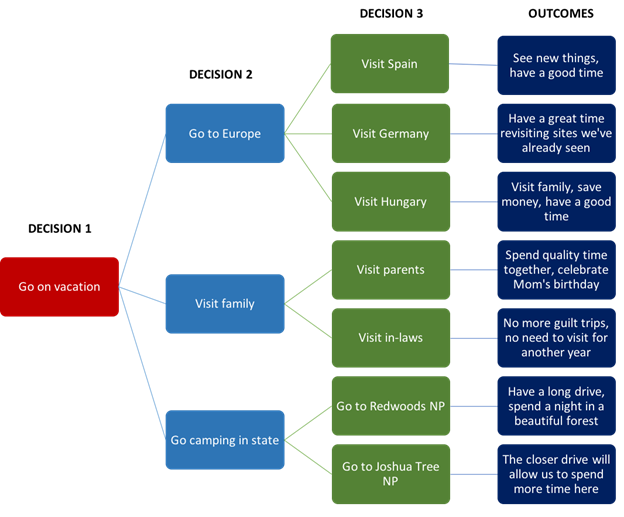18 The Decision Making Process
Decision Trees
Decision trees are useful tools, particularly for situations where financial data and probability of outcomes are relatively reliable. They are used to compare the costs and likely values of decision pathways that a business might take. They often include decision alternatives that lead to multiple possible outcomes, with the likelihood of each outcome being measured numerically.
A decision tree is a branched flowchart showing multiple pathways for potential decisions and outcomes. The tree starts with what is called a decision node, which signifies that a decision must be made.

From the decision node, a branch is created for each of the alternative choices under consideration. The initial decision might lead to another decision, in which case a new decision node is created and new branches are added to show each alternative pathway for the new decision. The result is a series of decision pathways. The flowchart might include only one or two decisions with only one or two alternatives, or it can become a complex sequence of many decisions with many alternatives at each node.
Along the decision pathway, there is usually some point at which a decision leads to an uncertain outcome. That is, a decision could result in multiple possible outcomes, so an uncertainty node is added to the tree at that point. Branches come from that uncertainty node showing the different possible outcomes.
Eventually, each pathway reaches a final outcome. The decision tree, then, is a combination of decision nodes, uncertainty nodes, branches coming from each of these nodes, and final outcomes as the result of the pathways.
Even in only this simple form, a decision tree is useful to show the possibilities for a decision. Once all of the possibilities are mapped out on paper, it may be easier to make an informed decision.
Decision Trees. Authored by: Aaron Spencer, David Thompson, PhD, and Lumen Learning. License: CC BY: Attribution
Decision Bias
In order to make good decisions, we use our knowledge and our reasoning. Often, this knowledge and reasoning is sound and solid. Sometimes, however, we are swayed by biases or by others manipulating a situation.
For example, let’s say you and three friends wanted to rent a house and had a combined target budget of $1,600. The realtor shows you only very run-down houses for $1,600 and then shows you a very nice house for $2,000. Might you ask each person to pay more in rent to get the $2,000 home? Why would the realtor show you the run-down houses and the nice house? The realtor may be challenging your anchoring bias. An anchoring bias occurs when you focus on one piece of information when making a decision or solving a problem. In this case, you’re so focused on the amount of money you are willing to spend that you may not recognize what kinds of houses are available at that price point.
The confirmation bias is the tendency to focus on information that confirms your existing beliefs. For example, if you think that your professor is not very nice, you notice all of the instances of rude behavior exhibited by the professor while ignoring the countless pleasant interactions he is involved in on a daily basis.
Hindsight bias leads you to believe that the event you just experienced was predictable, even though it really wasn’t. In other words, you knew all along that things would turn out the way they did.
Representative bias describes a faulty way of thinking, in which you unintentionally stereotype someone or something; for example, you may assume that your professors spend their free time reading books and engaging in intellectual conversation, because the idea of them spending their time playing volleyball or visiting an amusement park does not fit in with your stereotypes of professors.
Finally, the availability bias is when you make a decision based on an example, information, or recent experience that is that readily available to you, even though it may not be the best example to inform your decision.
Biases tend to maintain our preexisting knowledge, beliefs, attitudes, and hypotheses.
Summary of Decision Biases
| Bias | Description |
| Anchoring | Tendency to focus on one particular piece of information when making decisions or problem-solving |
| Confirmation | Focuses on information that confirms existing beliefs |
| Hindsight | Belief that the event just experienced was predictable |
| Representative | Unintentional stereotyping of someone or something |
| Availability | Decision is based upon either an available precedent or an example that may be faulty |
